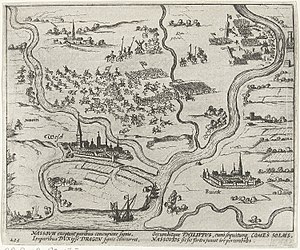| Battle of the Lippe | |||||||
|---|---|---|---|---|---|---|---|
| Part of the Eighty Years' War | |||||||
 'Defeat of the Dutch States Army near Wesel, 1595'. By Simon Frisius and Frans Hogenberg. | |||||||
| |||||||
| Belligerents | |||||||
|
|
| ||||||
| Commanders and leaders | |||||||
|
Cristóbal de Mondragón Juan de Córdoba |
Maurice of Nassau Philip of Nassau (DOW) | ||||||
| Strength | |||||||
| 500 cavalry | 500–700 cavalry | ||||||
| Casualties and losses | |||||||
| 60 | 100–300 | ||||||
The Battle of the Lippe was a cavalry action fought on 2 September 1595 on the banks of the Lippe river, in Germany, between a corps of Spanish cavalry led by Juan de Córdoba and a corps of Dutch cavalry, supported by English troops, led by Philip of Nassau. The Dutch stadtholder Maurice of Nassau, taking advantage of the fact that the bulk of the Spanish army was busied in operations in France, besieged the town of Groenlo in Gelderland, but the elderly governor of the citadel of Antwerp, Cristóbal de Mondragón, organized a relief army and forced Maurice to lift the siege. Mondragón next moved to Wesel, positioning his troops on the southern bank of the Lippe river to cover Rheinberg from a Dutch attack. Maurice aimed then, relying on his superior army, to entice Mondragón into a pitched battle, planning to use an ambush to draw the Spanish army into a trap. However, the plan was discovered by the Spanish commander, who organized a counter-ambush.
The Dutch intended to overtake a Spanish foraging convoy and deliver it into their camp in order to draw the Spanish army in pursuit to the banks of the Lippe, where Maurice was awaiting with the Dutch States Army in order of battle. However, Mondragón reinforced the escort of the convoy and hid a large force of cavalry in a wood nearby under his lieutenant Juan de Córdoba. Thanks to Mondragón's long experience, the Spanish routed the Dutch force and inflicted a number of casualties upon Philip of Nassau's men, including himself and several other high-ranking Dutch and English officers in the Dutch army.
